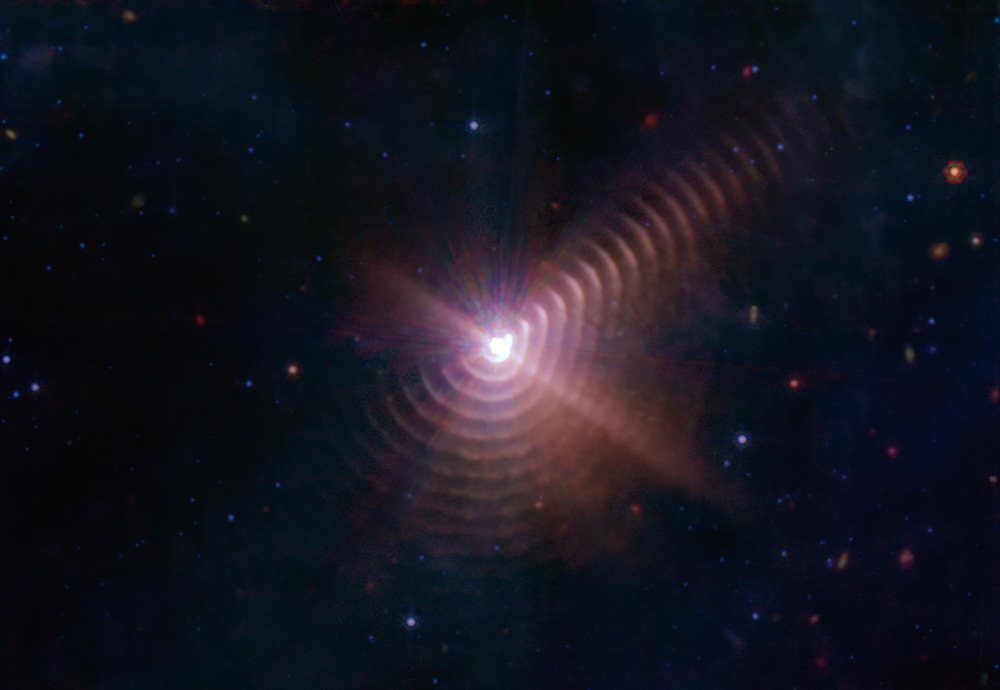Every time two giant stars swing around each other, they enrich the cosmos with complex organic molecules.
This summer, a newly reprocessed James Webb Space Telescope image appeared on Twitter: a strange, step-like pattern surrounding what appeared to be a single brilliant star.
The nebula’s resemblance to Inca terraces hatched some talk of aliens, but astronomers were excited for reasons much more tenuously connected to extraterrestrials. Here, they had firsthand evidence not only of Webb’s technical prowess as well as the method by which stars enrich the cosmos with complex organic molecules.
Ryan Lau (NSF's NOIRLab) and his colleagues had requested the Webb observations of this system, known as WR 140, because they already knew what it was, and what it might represent. At the center of WR 140 is not just one but two massive, blazing stars in a lively dance, swinging around each other every 8 years in a highly elongated orbit. One of these is an O star, still fusing hydrogen at its core, while the other is a Wolf-Rayet, a star not quite as massive but nearing the end of its short life. When the two interact, they make one of the universe’s most important ingredients: dust.
Cosmic dust doesn’t look like the stuff that collects on your living room corners — in space, the particles are so fine they’re more like what you’d find in cigarette smoke. But while cigarette smoke is decidedly bad for you, cosmic dust might be responsible for life itself. In a universe dominated by hydrogen gas, dust is what gloms together to form planets and maybe even lifeforms on those planets. (There’s the tenuous connection to aliens you were looking for.)
Turns out, Wolf-Rayet stars like the one in WR 140 make a good amount of soot-like particles. The aging giant has burned through its hydrogen and helium and is now blowing off a wind enriched in carbon; its O-star companion blows off its own wind, albeit weaker and less enriched. And for a few months every 8 years, when the two stars come closest together in their orbits, their winds slam into each other, forming dust.
Astronomers have imaged WR 140 before, resolving two nested dust shells around the star at infrared wavelengths. But Webb has a greater dynamic range and can make out faint emission near a bright source. So when it turned its infrared eye toward the system, its images revealed not just two but 17 nested shells of dust, representing 130 years of close approaches and dust-forming events. (We only see the shells’ edges, which is why they appear as rings.) Lau and colleagues present these observations in this week’s Nature Astronomy.

NASA / ESA / CSA / STScI / NASA-JPL / Caltech
Webb’s Mid-Infrared Instrument also took a spectrum of the second-innermost dust shell. In this “rainbow” of light, the dust shines brighter at wavelengths of 6.4 and 7.7 microns. Exactly what produces these two emission features isn’t yet known — in fact, astronomers call them “unidentified infrared” bands.
But what astronomers do know is that these bands are often seen in the presence of a complex molecule type known as polycyclic aromatic hydrocarbons (PAHs, where aromatic generally translates to “smelly”). These hexagon-shaped molecules are found in gasoline and cigarette smoke on Earth; in space, though, they’re the building blocks of dust grains and larger structures.
“The conclusion that they are likely seeing spatially resolved evidence of PAHs is strong, and really amazing,” says Joshua Thomas (Clarkson University). Thomas has studied the system with team members but wasn’t involved in the current study. “This research will definitely allow for a deeper dive into the environment that PAHs are forming in.”
While some Wolf-Rayet systems produce carbon-rich dust in pinwheel-like spirals, WR 140 has no proper spiral. The dust shells expand outward at some 2,600 kilometers per second (5.8 million mph), and the 8-year time lapse between the shells’ production means that each shell is nested inside the next. So the outermost shell we can see is also the oldest, and the most recent close pass between the stars in 2016 produced the innermost shell.
Some of the expansion comes from the outward flow of the winds themselves. But a second study, this one in Nature, this one led by team member Yinuo Han (University of Cambridge, UK), finds that the central stars’ radiation is also pushing on the individual dust grains, accelerating them out of the system and into the space between stars.
Interstellar dust grains eventually settle into stellar nurseries, the smallest building blocks of planets forming around newborn stars. “This carbonaceous dust should indeed go on to form future stars and planets,” Lau says. “It's hard to say right now if it goes on incorporated in life though! We'll need a few more steps to make that connection.”
“I feel all science is incremental, but this certainly feels like a larger than normal step,” Thomas says. This is definitely something to be excited about.”
 2
2









Comments
Lou
October 14, 2022 at 2:57 am
Just amazing! Cheers for the extra info on PAHs - not mentioned elsewhere. I can see how the shells are affected by winds and light, but I wonder if the orbital motion also plays a role in shaping them?
You must be logged in to post a comment.
robin_astro
October 15, 2022 at 3:58 pm
There were Pro-Am campaigns using spectroscopy to define the orbits more precisely during the the periastrons in 2009 and 2016 that produced the two inner shells. Fascinating to see the resulting dust propagating out into the surrounding space.
These were the resulting papers.
https://ui.adsabs.harvard.edu/abs/2011MNRAS.418....2F/abstract
https://ui.adsabs.harvard.edu/abs/2021MNRAS.504.5221T/abstract
You must be logged in to post a comment.
You must be logged in to post a comment.